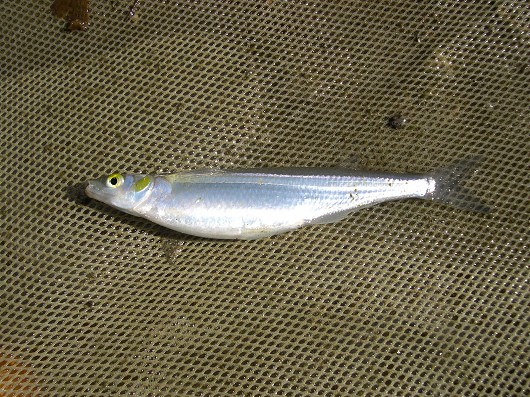Topsmelt
-
Scientific NameAtherinops affinis
-
NativeYes
-
Identification
 Topsmelt, captured from the Santa Clara River Estuary, Ventura County, CA on 28 March 2004. Photo by Steve Howard.
Topsmelt, captured from the Santa Clara River Estuary, Ventura County, CA on 28 March 2004. Photo by Steve Howard.- Small and slim, up to 37 cm TL
- Fattened dorsally, lateral line absent
- Two dorsal fins separated
- Small oblique mouth: one row of tiny forked teeth per jaw
- Bright green back, silver to pale sides, silvery underside
- Juveniles: translucent white with midline stripe, 3 pigmented scale rows on back-scattered on caudal peduncle
- Fin spines/rays: 1st dorsal 5-9 spines, 2nd dorsal 1 spine/8-14 rays, anal 1 spine/19-25 rays, pectoral 13 rays
- Lateral line scales: line absent, 63-65 lateral scales
-
Life History
Topsmelt are primarily marine fish, though they are commonly found in bays, estuaries, and the mouths of coastal streams. They are capable of living in water with salinities ranging from fresh to pure sea water and in temperatures ranging from 5 to 29°C. Topsmelt are also capable of surviving exposures to extreme salinities up to 80 ppt. They are rarely found in freshwater and fish occupying fresh or brackish waters are usually young-of-year. Topsmelt are benthically oriented and usually feed by grazing the bottom of the water column. These omnivores may feed on diatoms, algae, detritus, chironomid midge larvae, and amphipods. Juvenile Topsmelt are more likely to be found in freshwater and are less benthically focused. They have been found to consume various kinds of zooplankton. As juvenile fish age and develop they begin moving farther down into the estuary. Topsmelt spawn from March through October with optimal spawning waters having a salinity around 30 ppt and a temperature range of 13-27°C. Larvae move into deeper water when they hatch and may move up the estuary.
-
Links to Other ResearchN / A
